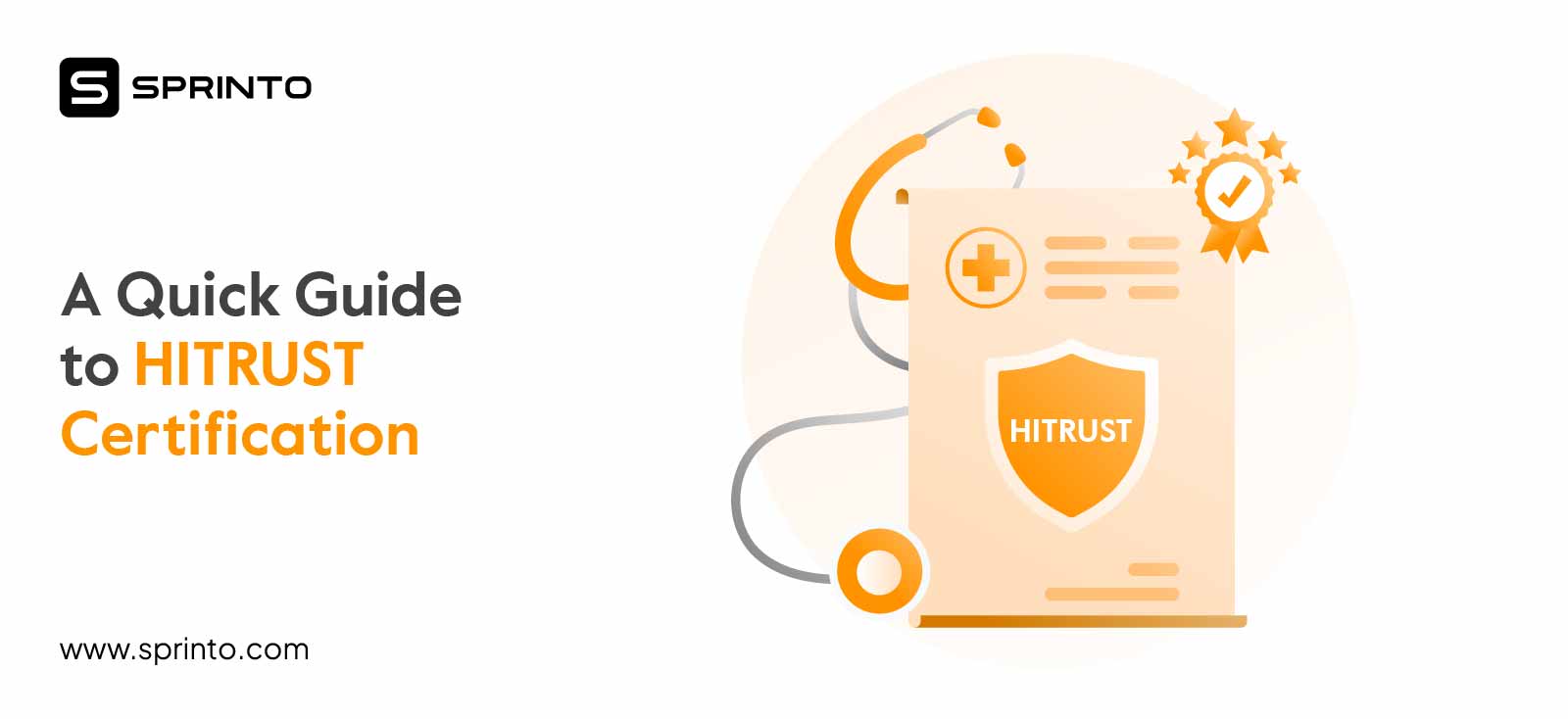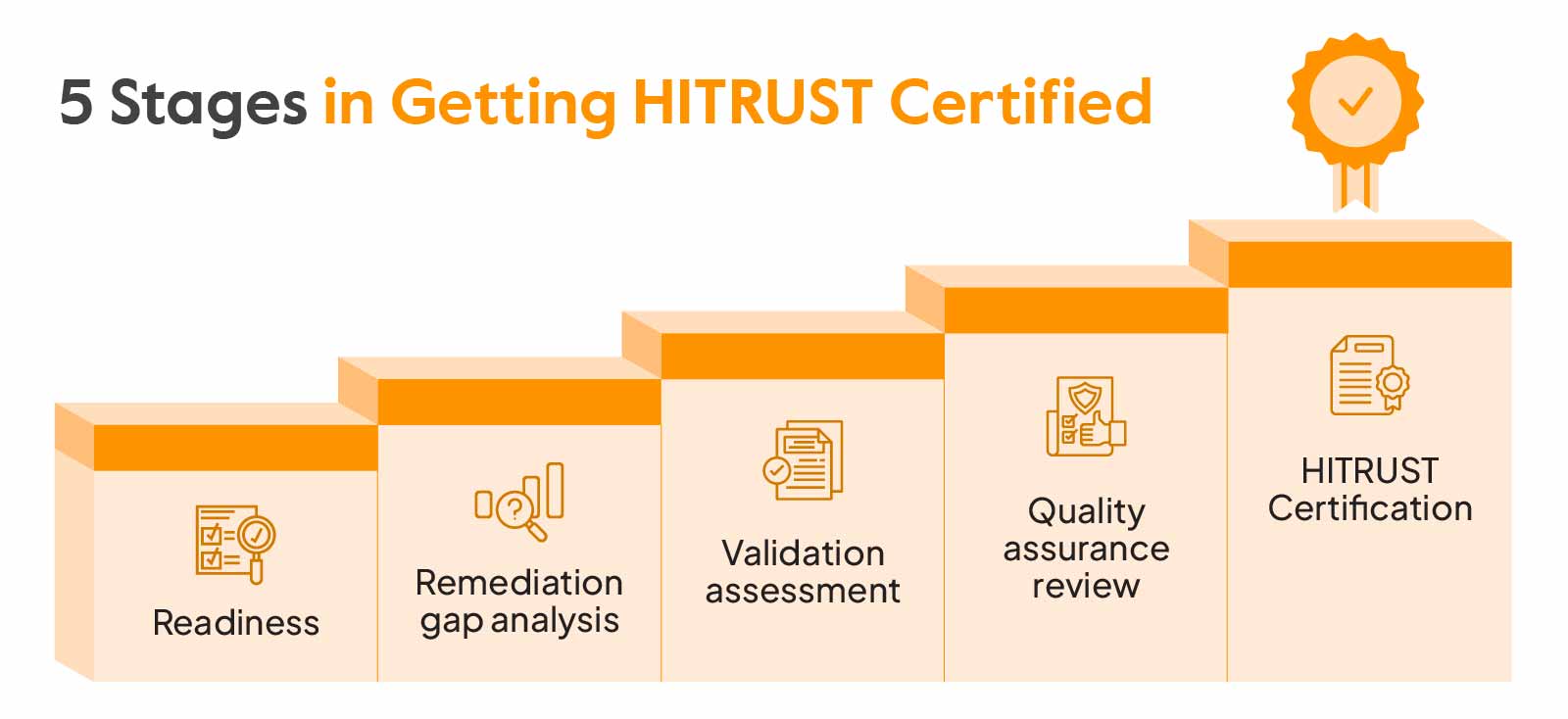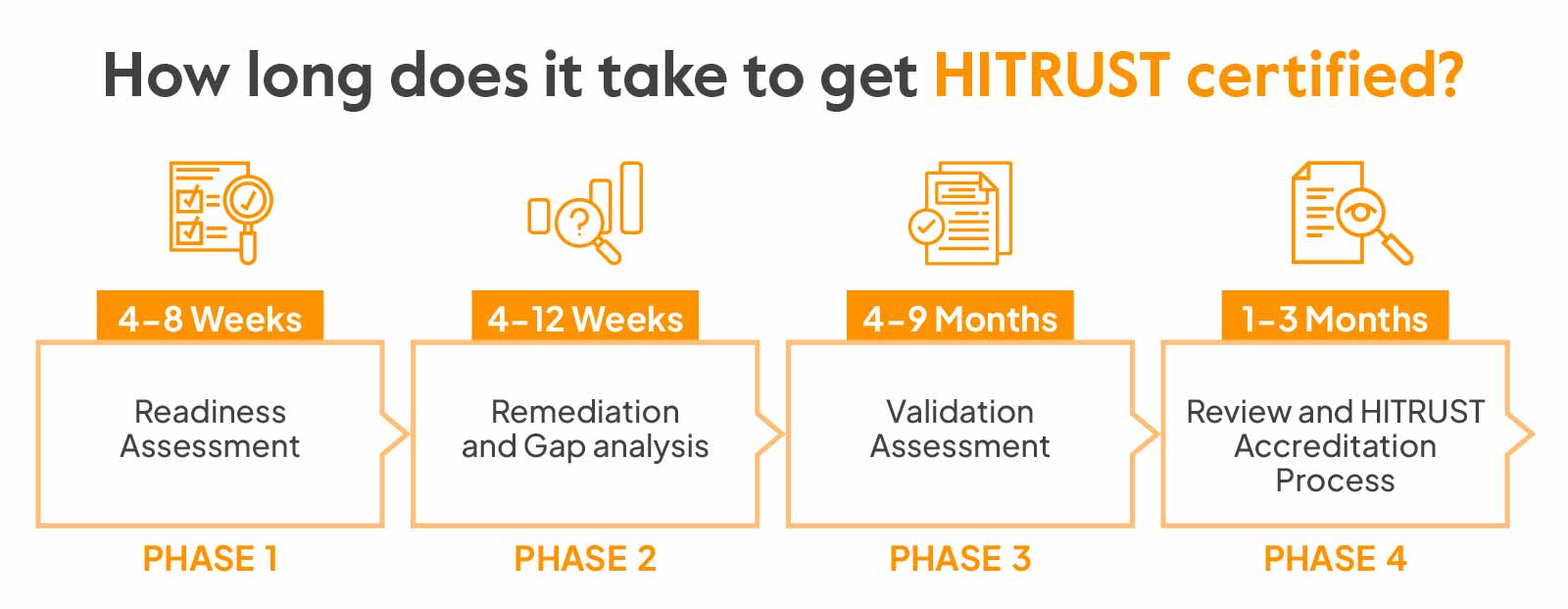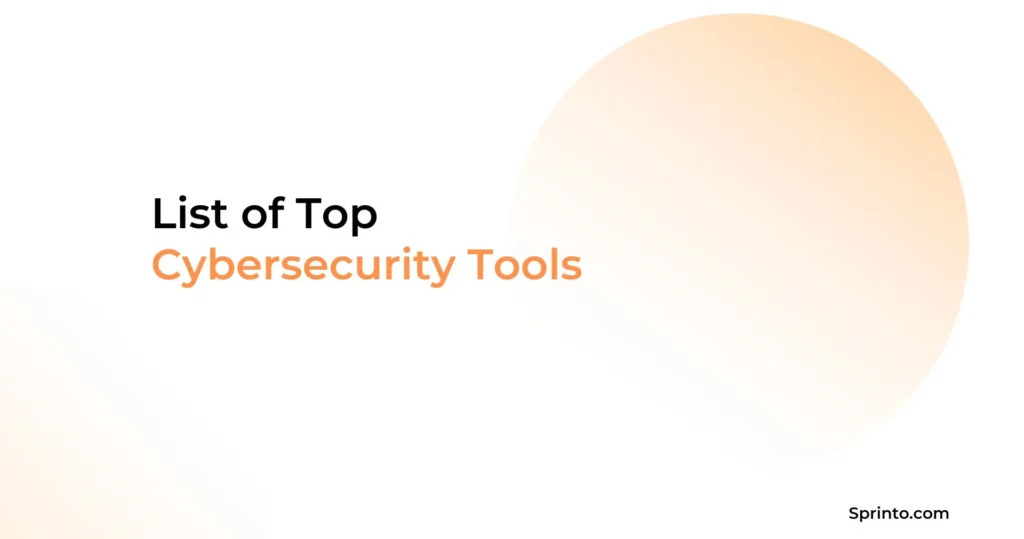
For companies in healthcare, obtaining a HITRUST(Health Information Trust Alliance) Certification acts as a benchmark to ensure data protection standards. According to a survey by HIMSS, 81 percent of US hospitals and health systems and 83 percent of health plans utilize HITRUST, making it the widely adopted control framework in the healthcare sector.
Today, the healthcare sector is one of the attractive targets for malicious actors due to the sheer and tremendous volume of sensitive data it holds. And hence, the safeguards implemented across the industry holds special significance.
With this in mind, the HITRUST Alliance has introduced the CSF (Common Security Control Framework), allowing healthcare service providers and covered entities to certify their cybersecurity posture. This blog will elaborate on the requirements, cost, and the challenges of HITRUST certification.
What is HITRUST certification?
HITRUST Certification is a cyber security certification developed by the HITRUST Alliance, which details a set of specifications that covers aspects of data security and handling for the healthcare space. It enables vendors and covered entities to demonstrate compliance with frameworks such as HIPAA.
HITRUST a certifiable security and privacy framework ensures the information security for Health Information Networks through an independent assessment. HITRUST Certification offers three levels of assurance which includes self-assessment, CSF validated, and CSF-certified, with the highest level meeting all certification requirements. FedRAMP aligns with HITRUST, but achieving FedRAMP Certification requires separate consideration.
HIPAA (Health Insurance Portability and Accountability Act) is a US federal law that standardizes the best practices to protect patient data and personal health information. The government has mandated that all healthcare providers that process PHI are required to meet HIPAA standards or will be held liable to legal measures and/or applicable fines.
This HITRUST CSF acts as a comprehensive solution that helps healthcare organizations comply with HIPAA and other relevant regulatory compliance. Although the government does not enforce the healthcare adopts it as the gold standard for data security.
Related reading: The difference between HIPAA and HITRUST
Why do you need to get HITRUST CSF certification?
Organizations, especially in the healthcare industry, must get HITRUST CSF certification because the framework establishes prescriptive controls that can be tailored towards organizational needs to achieve security and compliance. The rigorousness of the assessment enhances resilience and contributes to market credibility.
Here’s why you need to get HITRUST CSF certification:

- HITRUST is a widely accepted security framework in the U.S., and the HITRUST CSF certification (r2 validated assessment especially) is considered the gold standard for information protection. This is because of the comprehensiveness and depth of review it offers.
- HITRUST integrates requirements from authoritative sources like NIST, ISO 27001, PCI, and more to incorporate about 2000 controls into one framework. CSF implementation can, therefore, build an effective information protection program.
- HITRUST keeps updating its policies and programs to stay abreast of emerging threats and evolving regulatory requirements. This ensures that you keep pace with the changes in the digital landscape.
- The assessment submitted by the external assessor undergoes 150 automated quality checks followed by 5 independent quality reviews. This rigorous assessment process proves that getting certified is no easy feat and builds a solid public perception.
Also check out: HIPAA vs HITRUST: Understanding 6 Main Differences
HITRUST certification requirements
The HITRUST framework has controls grouped into categories. Each control category includes implementation requirements that provide details to help organizations set down the desired technical controls in place to meet the objectives.
HITRUST Certification requirements defines 3 progressive implementation levels for each requirement—levels 1, 2, and 3. Level 1 has the minimum requirements. Level 2 adds on Level 1 with additional requirements. The 3rd Level includes everything from Levels 1 and 2 plus more requirements.
The implementation levels account for an organization’s risk factors, regulations, resources, and the type of HITRUST assessment being done. HITRUST also lets organizations include specific community requirements like industry groups or cooperative sharing agreement standards and other regulatory factors during the assessment.
How to get HITRUST certification?
HITRUST certification indicates an organization is serious about protecting sensitive healthcare information. The certification process enables companies to gauge their security against industry benchmarks and confirm their controls through comprehensive assessment.
The process of getting Hitrust certified can take up to 18 months, depending on organisation size and requirement. This process involves readiness, gap analysis, validation assessment and quality assurance. At a high level, being HITRUST certified usually entails going through the following stages:
Here are the 5 stages to get HITRUST certified:

Step 1 :Readiness Assessment
The Readiness Assessment process, called self-assessment, is now revamped as the HITRUST Basic, Current-State (bC) Assessment. As the certification’s first phase, the assessment leverages the HITRUST CSF tools and methods. The assessment is part of the HITRUST CSF Assurance program and assists the organization in evaluating its operational processes. Organizations can work with HITRUST Approved External Reviewers to facilitate the process and for effective guidance.
Step 2 :Remediation gap analysis
After the readiness assessment, the project coordinator or HITRUST Authorized External Assessor will recommend strategies for improvement since the HITRUST regulations keep evolving. Regular assessments are essential to bridge gaps in your security program. A thorough gap analysis helps you identify operational procedures, policies, access controls, and documentation that need to be updated as per the current HITRUST CSF requirements. Gap analysis can be performed using an assessment questionnaire that describes the scope and other corrective action plans.
Experience the Sprinto Advantage: Our smart compliance automation solution helps you uncover any security gaps and assists you in getting ready with an action plan to address them.
Step 3 :Validation assessment
During this segment of the certification process, the assessor tests the defined controls of each designated category. An on-site risk assessment usually includes interviews with key personnel, reviewing supporting documents and security measures, sampling, penetration testing, and vulnerability scans.
Each requirement is evaluated based on attributes such as Policy, Process/Procedure, and Implementation. The evaluation scores the organization as per the level of compliance. That is, which controls are fully compliant, partial, or non-compliant. After the authorized personnel review and validate the score, they send it to HITRUST for approval.
Step 4 :Quality assurance review
When a validated assessment is complete and submitted for review, HITRUST employs various testing techniques to ensure appropriate implementation of security controls. The duration ranges from 4 to 8 weeks. The HITRUST Quality Assurance Review gives an extra layer of reliability to organizations that count on the assurances from entities going through a HITRUST assessment.
After the review is done, a final HITRUST CSF Validated Assessment Report is released, either with certification or without, depending on the results.
Step 5 :HITRUST Certification
It’s finally time for the HITRUST certification once the entity successfully completes the review and meets all the security control requirements of the HITRUST framework. After the review, the HITRUST External Assessor oversees the scoring of all the assessments, and then HITRUST approves and certifies them.
How long does it take to get HITRUST certified?
It can take up to 18 months to get HITRUST Certified, based on your organization’s size and complexity. Here is the breakdown of the certification process:
Phase 1 Readiness Assessment: 4-8 weeks
Phase 2 Remediation and Gap analysis: 4-12 weeks
Phase 3 Validation Assessment: 4-9 months
Phase 4 Review and HITRUST Accreditation Process: 1-3 month

Sprinto Advantage: Sprinto is a compliance automation platform that supports healthcare industry frameworks such as HIPAA. It offers an intuitive health dashboard that displays the compliance and security status of the organization in real-time, allowing you to stay compliant.
Looking to significantly reduce the time to certification?
Learn how you can get HITRUST-certified in a week
How much does HITRUST Certification Cost?
At the lower end, the direct costs of HITRUST CSF certification can start from $30000, but the overall costs can exceed $160000. This is because the costs depend on several factors: organizational size, security maturity, level of compliance and more.
Direct costs for certification include access to the MyCSF corporate portal, gap analysis, readiness assessment, validation testing, and consultation costs if required.
Indirect costs include internal resource costs, technological deployments, ongoing compliance costs, remediation efforts, etc.
Other factors such as the complexity of IT systems and the extent of the utilization of sensitive data influence the risk level and total cost. The readiness assessment allows the assessor to estimate the cost specific to the organization’s unique risks and helps the organization budget appropriately for the entire HITRUST certification process.
Challenges you may face in getting HITRUST certified
Although it is a common security framework, obtaining HITRUST certification can take time and effort.
Here are some of the challenges you may face with this compliance program.
- Massive amount of prep work required beforehand
- The complete documentation of compliance can be very time-consuming
- Fixing weaknesses identified during assessment
- Getting new systems and policies in place to resolve security and compliance issues can be expensive
- Large companies may need help to coordinate and roll-out measures across systems and business units
- Staying certified means repeating assessments periodically and keeping up with framework changes
- Buy-in and resource allocation is not simple but both tasks are critical for the organization to succeed
Conclusion
The points mentioned above detail the importance of being HITRUST certified. The certification offers unparalleled risk management and overall cybersecurity while making compliance requirements easier to follow. However, taking care of all the requirements can get hectic. Luckily, there is a smart way to breeze past the complex compliance process—Sprinto.
Sprinto ensures you streamline your compliance tasks and expedite your HITRUST certification process. The platform also allows you to intuitively map common controls with other frameworks like HIPAA so you don’t have to start from scratch. Your compliance team is also able to help you stay compliant and monitor all your security controls in real-time while alerting you when controls are about to fail.
Read about how Sprinto made Neurosynaptic achieve HIPAA certification in weeks.
FAQs
Is HITRUST only for healthcare?
No HITRUST is not only for healthcare. Though initially created to ensure data security in the healthcare industry, today, the framework has expanded to encompass security standards in all domains.
What is the difference between HIPAA and HITRUST?
The primary difference between the two regulatory standards is HIPAA is a US law that governs the healthcare industry requirements for protecting PHI, while HITRUST is a global risk and security management framework that covers many HIPAA-mandated security Controls. Hence, getting HITRUST certification will ease your compliance with HIPAA.
What is the purpose of HITRUST?
The purpose of HITRUST is to help organizations safeguard sensitive data, manage information risks, and achieve compliance by following all regulatory requirements effectively.
What is the difference between HITRUST and NIST?
Firstly, after implementing the HITRUST requirements and controls, you can obtain HITRUST certification, and that’s not the case with NIST. Also, to achieve NIST compliance, there are a total of 108 security controls, whereas HITRUST encompasses 1800 security controls.
What types of businesses should obtain HITRUST certification?
Any organization that deals with sensitive information must obtain HITRUST certification. This includes healthcare providers such as hospitals, clinics and pharmaceuticals, telemedicine providers etc. It also includes other businesses dealing with critical information that must address risk and compliance management.
How long is HITRUST certification valid?
HITRUST certification (r2) is valid for 24 months and requires an interim assessment after 12 months. The interim assessment is an assurance of the ongoing effectiveness of implemented controls.
Does HITRUST replace HIPAA?
No, it does not. HITRUST certification requirements can lay the foundation for implementing HIPAA controls but it cannot replace HIPAA compliance.
How many domains does HITRUST have?
HITRUST has 19 domains which are further divided into controls followed by 3 levels of implementation.
Gowsika
Gowsika is an avid reader and storyteller who untangles the knotty world of compliance and cybersecurity with a dash of charming wit! While she’s not decoding cryptic compliance jargon, she’s oceanside, melody in ears, pondering life’s big (and small) questions. Your guide through cyber jungles, with a serene soul and a sharp pen!
Explore more
research & insights curated to help you earn a seat at the table.









![HIPAA Certification Cost [Updated 2024 + Free Checklist]](https://sprinto.com/wp-content/uploads/2024/04/HIPAA-Certification-Cost-Updated-2024-Free-Checklist-1024x675.jpg)











